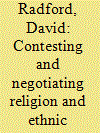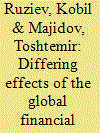| Srl | Item |
| 1 |
ID:
128675


|
|
|
|
|
| Publication |
2014.
|
| Summary/Abstract |
Post-Soviet Central Asia has inherited a set of circumstances conducive to the revitalization of religion. The renewal of Muslim awareness and identity in Central Asia may not be surprising, but the growth of Christianity is, especially in its Protestant form within indigenous Muslim communities. This article, based on qualitative field research, reviews one example of this development: the process of conversion to Protestant Christianity among Muslim Kyrgyz in Kyrgyzstan. A prominent aspect of this social movement has been the ways in which Kyrgyz Christians have entered into a dynamic process of engaging with issues of identity and what it means to be Kyrgyz - a process that has sought to locate their new Christian religious identity within, rather than on the margins of, familial and ethnic identity, and one that challenges the normative understanding of Kyrgyz identity: that to be Kyrgyz is to be Muslim. While providing the context for Kyrgyz conversion, this discussion primarily focuses on the way Kyrgyz Christians utilize a number of different discursive strategies to contest normative Kyrgyz identity constructs and to legitimize a Kyrgyz Christian identity.
|
|
|
|
|
|
|
|
|
|
|
|
|
|
|
|
| 2 |
ID:
120682


|
|
|
|
|
| Publication |
2013.
|
| Summary/Abstract |
Kazakhstan, the Kyrgyz Republic and Uzbekistan are neighbouring countries in post-Soviet Central Asia which share similar culture and language. Their economic structures were similar under central planning: they provided the agricultural basis to the Soviet economy. But, since independence, these economies have grown structurally more heterogeneous due to variations in the implementation of market-oriented reforms, the degree of integration into the global economy and natural resource endowment. This article attempts to demonstrate how this heterogeneity can explain the differing effects of the recent Global Financial Crisis on these countries' economies in general and in the banking sector in particular.
|
|
|
|
|
|
|
|
|
|
|
|
|
|
|
|